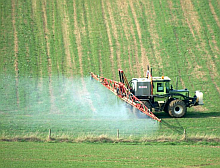Background
The use of pesticides
and their possible
health effects is
a subject that gives
rise to much public
concern and discussion.
There have been
reports of ill health
attributed to pesticide
exposure. In particular,
some people living
next to agricultural
land, rightly or
wrongly, attribute
health problems
to their exposure
from pesticides
sprayed on these
fields. There is
currently a lack
of reliable exposure
information for
residents and bystanders
in the UK.

- In a previous
study, we showed
that the methods
currently used
for assessing
pesticide exposure
for regulatory
purposes were
appropriate
for farm workers.
- However,
the method appeared
to underestimate
the actual levels
of exposure
for bystanders.
- No measurements
were collected
for residents
and it was recommended
that further
work be carried
out to collect
measurements
to determine
if current tools
and methods
are appropriate
for assessing
exposure for
residents living
near fields.
Who is organising
and funding the
research?
In Great Britain
the use of pesticides
in agriculture,
horticulture, forestry,
food storage and
the home or garden
is regulated to
protect human health
and the environment.
The regulatory system
is administered
by the Department
for Environment,
Food and Rural Affairs
(DEFRA). DEFRA have
asked that the Institute
of Occupational
Medicine (IOM) to
investigate pesticide
exposure during
the spraying season
amongst residents
(adults and children)
living next to agricultural
fields and to assess
if the current pesticide
regulatory system
provides suitable
protection for those
people exposed.
What is the
purpose of the study?
This study will
investigate pesticide
exposure during
the spraying season
amongst residents
(both adults, aged
18 years and over,
and children, aged
4 years and over)
living next to agricultural
fields and will
assess whether the
current system used
to regulate pesticide
exposure provides
suitable protection
for those people
exposed. We will
do this by collecting
urine samples from
residents and will
compare the levels
of pesticide metabolites
in the urine of
people that have
been exposed to
pesticides due to
spraying with the
level of residue
predicted from data
obtained from a
variety of sources,
including mathematical
models. The end
result will determine
if the current system
used to regulate
pesticide exposure
provides suitable
protection for those
people exposed
|